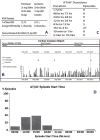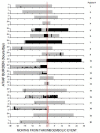The Temporal Relationship Between Atrial Fibrillation and Ischemic Stroke
- PMID: 28496811
- PMCID: PMC5153106
- DOI: 10.4022/jafib.738
The Temporal Relationship Between Atrial Fibrillation and Ischemic Stroke
Abstract
It is well established that the presence of atrial fibrillation (AF) is associated with an increased risk of stroke; however, the precise role that AF plays in increasing this risk is less well understood. In particular, it is not fully known whether a temporal relationship between AF and stroke exists. Early clinical trials in this field were limited by their rudimentary tools for monitoring of AF recurrences. More recently, studies employing implantable cardiac rhythm devices have brought greater precision to our ability to accurately detect and quantify episodes of AF but have been restricted to patient populations with clinical indications for those types of devices.In the future, new monitoring modalities such as subcutaneous devices and external patches may allow us to extend precise arrhythmia monitoring to the broader AF population. Due to the relatively low rate of clinical events, large clinical trials or registries will be required to fully appreciate the temporal aspects of AF and stroke and alternative metrics for quantifying AF recurrences need to be explored.
Figures




Similar articles
-
Silent Atrial Fibrillation: A Critical Review.J Atr Fibrillation. 2014 Oct 31;7(3):1138. doi: 10.4022/jafib.1138. eCollection 2014 Oct-Nov. J Atr Fibrillation. 2014. PMID: 27957123 Free PMC article. Review.
-
Does atrial fibrillation detected by cardiac implantable electronic devices have clinical relevance?Cardiol Clin. 2014 May;32(2):271-81. doi: 10.1016/j.ccl.2013.11.001. Epub 2014 Feb 1. Cardiol Clin. 2014. PMID: 24793802 Review.
-
Long-term rhythm monitoring with an implantable loop recorder in patients after the first clinical atrial fibrillation episode. Towards an individualized management.Minerva Cardioangiol. 2019 Apr;67(2):121-130. doi: 10.23736/S0026-4725.19.04883-7. Epub 2019 Feb 5. Minerva Cardioangiol. 2019. PMID: 30724269 Review.
-
Silent ischaemic brain lesions related to atrial high rate episodes in patients with cardiac implantable electronic devices.Europace. 2015 Mar;17(3):364-9. doi: 10.1093/europace/euu267. Epub 2014 Oct 21. Europace. 2015. PMID: 25336664
-
Role of cardiac electronic implantable device in the stratification and management of embolic risk of silent atrial fibrillation: are all atrial fibrillations created equal?Expert Rev Cardiovasc Ther. 2018 Mar;16(3):175-181. doi: 10.1080/14779072.2018.1438267. Epub 2018 Feb 15. Expert Rev Cardiovasc Ther. 2018. PMID: 29431527 Review.
Cited by
-
Deciphering the Role of microRNAs: Unveiling Clinical Biomarkers and Therapeutic Avenues in Atrial Fibrillation and Associated Stroke-A Systematic Review.Int J Mol Sci. 2024 May 20;25(10):5568. doi: 10.3390/ijms25105568. Int J Mol Sci. 2024. PMID: 38791605 Free PMC article.
-
CHA2DS2-VASc score predicts 30-day readmission due to thromboembolic complications following cardioversion of atrial fibrillation: insights from US National Readmissions Database.J Interv Card Electrophysiol. 2019 Oct;56(1):55-61. doi: 10.1007/s10840-019-00593-0. Epub 2019 Jul 22. J Interv Card Electrophysiol. 2019. PMID: 31332606
-
Is there a temporal relationship between atrial fibrillation and stroke? A review.BMJ Neurol Open. 2024 Jan 24;6(1):e000512. doi: 10.1136/bmjno-2023-000512. eCollection 2024. BMJ Neurol Open. 2024. PMID: 38288314 Free PMC article.
References
-
- Miyasaka Yoko, Barnes Marion E, Gersh Bernard J, Cha Stephen S, Bailey Kent R, Abhayaratna Walter P, Seward James B, Tsang Teresa S M. Secular trends in incidence of atrial fibrillation in Olmsted County, Minnesota, 1980 to 2000, and implications on the projections for future prevalence. Circulation. 2006 Jul 11;114 (2):119–25. - PubMed
-
- Wolf P A, Abbott R D, Kannel W B. Atrial fibrillation as an independent risk factor for stroke: the Framingham Study. Stroke. 1991 Aug;22 (8):983–8. - PubMed
-
- Wolf P A, Kannel W B, McGee D L, Meeks S L, Bharucha N E, McNamara P M. Duration of atrial fibrillation and imminence of stroke: the Framingham study. Stroke. 1983 Sep 1;14 (5):664–7. - PubMed
-
- Lin H J, Wolf P A, Benjamin E J, Belanger A J, D'Agostino R B. Newly diagnosed atrial fibrillation and acute stroke. The Framingham Study. Stroke. 1995 Sep;26 (9):1527–30. - PubMed
-
- Sacco R L, Ellenberg J H, Mohr J P, Tatemichi T K, Hier D B, Price T R, Wolf P A. Infarcts of undetermined cause: the NINCDS Stroke Data Bank. Ann. Neurol. 1989 Apr;25 (4):382–90. - PubMed
Publication types
LinkOut - more resources
Full Text Sources
